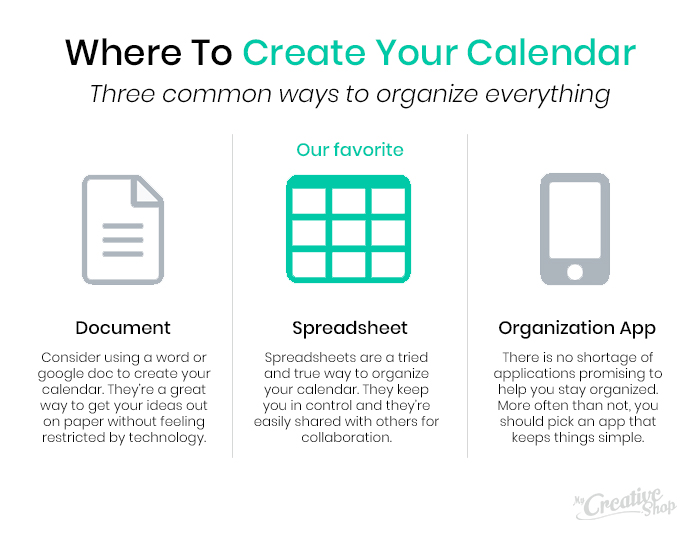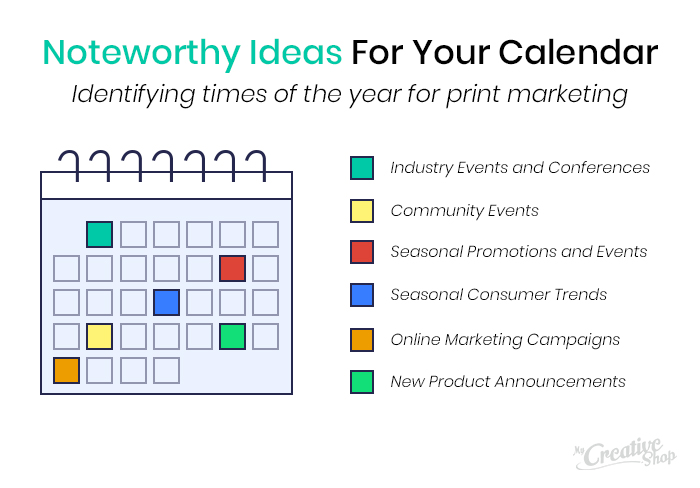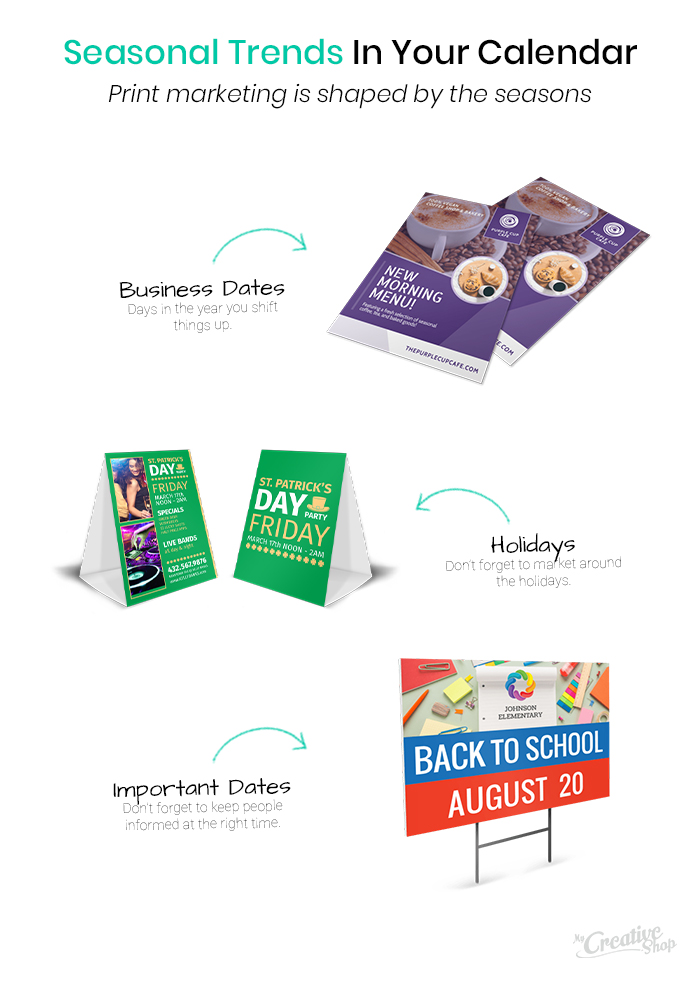How to Create a Marketing Calendar for Print Advertising


A marketing calendar is like the business plan for your marketing efforts. It guides the way as you grow and evolve as a business. It also ensures that you have the right budget for what you want to do, but more importantly that you re using it wisely, at the right times of year and with the best mediums.
As a small business, this is likely one of the most important reasons to plan ahead: 29 percent of small businesses fail because they run out of cash. If you re spending on marketing without a plan, you run the risk of losing money and potential customers.
If you don t have a marketing calendar for your print campaigns yet, now s the time to put your ideas on paper and make a plan. Keep the following tips and ideas in mind as you develop your marketing calendar.
How to Format Your Calendar
You can create your calendar in a document, spreadsheet, or even with a to-do list app, depending on which format works best for you. Make sure that it s available online, so you, and anyone else involved can access it at all times.

Your print marketing calendar should be a tool to help you plan in advance and stay on track with print needs. Each item on your calendar should also include specific milestones for printing to make sure you re not left scrambling days before your flyers are needed for canvassing, for example. This also leaves time to fix any mistakes or make design changes.
At MyCreativeShop, our rule of thumb is to start the design and print process 4 to 5 weeks in advance; the bigger the holiday, the longer time you need.
If you had a business event on 7/25/2019 for example, your calendar might look something like this:
- Start designing brochures by 6/19/2019
- Start designing flyers by 6/21/2019
- Update business cards by 6/25/2019
What to Include in Your Calendar
Now that you know how to format your marketing calendar, it s time to talk about what you should include, from marketing events to product announcements, so you can plan accordingly. Here are a few key areas to keep in mind as you build your print marketing roadmap.

Industry Events and Conferences
Events are often costly not just because of the materials needed, but paying for flights, food, and accommodations is pricey. To make the most of each one, you need to have tangible materials potential customers will leave with. Adding the event to your calendar, along with items needed, will help you keep them top of mind.
To get started, make a list of the materials you need and add them to your calendar, giving yourself plenty of time to get everything designed, purchased and printed.
Community Events
While your marketing calendar will fill up fast, use this time to plan for local and community events as well. These events are important to network with local residents who can quickly become your most loyal customers and your best word-of-mouth advertisers. You can find out about local events on city or community websites. Ask fellow business owners which events they find are most valuable and use that as a point of reference as well.
Just like with large conferences, use the calendar to make sure everything is ready ahead of time, from swag to business cards. Make the most of these community events, and get some more ideas about how to reach your local customers, with our ideas in 5 Proven Community Marketing Strategies.
Seasonal Promotions and Events

List all of your known seasonal marketing events and promotions. For example, every summer you host a community Barbecue and in the fall, you run a food drive, so both of these get added to the calendar. Next, list out the print marketing materials you ll need for each one. For example:
- Flyers
- Restaurant banner
- Table tents
- Stickers
Follow the milestone format to plan out when the materials should be ready. Always include a specific date because specific details add accountability. Learn more about what offline marketing materials you can use to promote the events you ve planned in our blog post, How to Market Your Local Event Without Social Media.
Seasonal Consumer Trends
Don t forget to consider general shifts in season and how that will affect your print materials. For example, a restaurant may change its menu each season this would be on the print marketing calendar to account for the budget needed to design and print those menus. Here are some other examples:

If you re not sure what the most important seasonal trends are for your business, use industry insights to guide you. For example, according to the National Retail Federation, the top consumer events include the winter holidays, and back to school or college. Planning ahead with your marketing calendar ensures that you re able to capitalize on these opportunities to boost revenue.
Restaurant business owners can also get more print ideas for seasonal trends in our blog post, Restaurant Marketing: Print Ideas for New Business Owners.
Online Marketing Campaigns
Print marketing can be used to supplement your online marketing efforts. An ecommerce seller, for example, can plan a direct mail campaign to promote specific online products, driving traffic from both online sources and print marketing. Use your calendar to find areas of the year where print can support your digital marketing.
New Product Announcements
The launch of a new product or line is stressful, so don t save the planning until you re in the thick of it. Use this time as a chance to brainstorm creative ideas for driving sales and customer interest so you can execute when you re ready to share the announcement.

The print materials needed for this might include direct mail postcards, flyers, table tents, new menus, cup sleeves or door hangers, depending on what kind of business you are. For example, a local bakery may plan to start offering gluten-free bagels in 3 months. Print materials that could be beneficial are:
- Cup sleeves, reminding customers of the new menu item
- New to-go menus
- New cafe menus
- Table tents, sharing the announcement
- EDDM direct mail postcards to target customers most interested
Create Your Marketing Calendar Now
Planning your marketing calendar in advance may be time-consuming, but it will pay off in the long run. Not only does planning ahead save time, but it also ensures you re doing your due diligence to grow your business:
Having a plan in place that outlines your marketing activities on a month-to-month basis assures that a steady stream of promotion enters the marketplace, keeping you in the minds of your established customers and roping in new ones. The more you talk about your company, the more likely people will overhear and become curious, explain experts at BigCommerce.
Get your print materials in order by creating your marketing calendar in 3-, 6- or 12-month increments. Avoid scrambling, give yourself time to brainstorm creative ideas, and use your budget wisely to grow and thrive as a small business.
